Textiles: Can We Make Fashion Sustainable?
12 minute read
Updated on: 29 Apr 2021
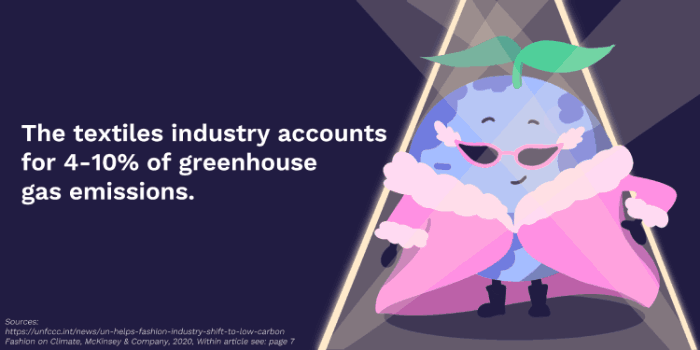
What are textiles?
The textiles industry involves the production and processing of fibres and filaments, and their subsequent assembly into fabrics and clothes . While this includes household and industrial fabrics, we will mainly focus on the fashion industry as it is responsible for 70% of textile production
.
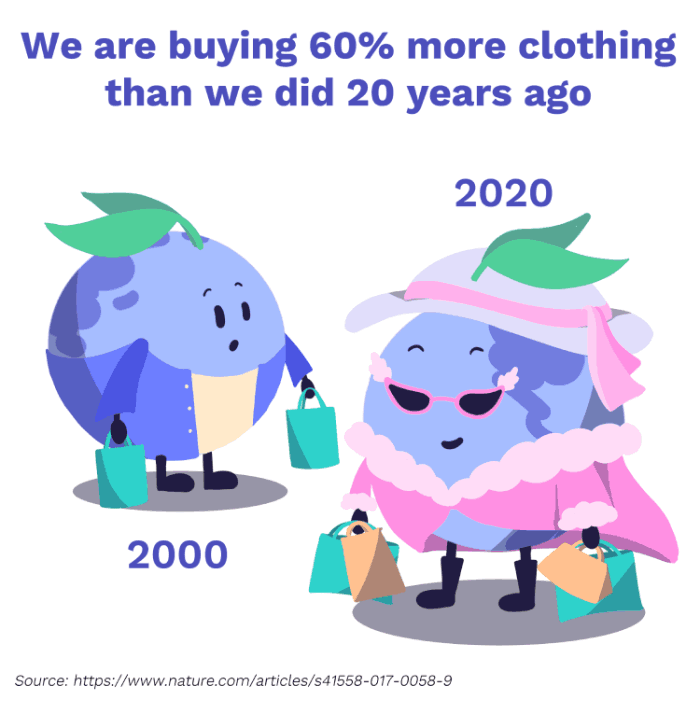
We buy 60% more clothing than we did 20 years ago.
This dramatic increase has been accelerated by the development of “fast fashion”, a business model characterised by low prices and fast-paced trends .
What does this mean for the planet?
On average, making 1 kg of fabric releases 20-23 kg of greenhouse gas , and the industry is estimated to account for 4-10% of man-made global greenhouse gas emissions, depending on the calculation methods used
. Compare this to the aviation industry, which contributes just 2.4% of global emissions
!
So where do these emissions come from?

Emissions contribution of fashion supply chain
Emissions are produced at all stages of a garment’s lifetime; from sourcing the raw materials to its laundry and disposal. However, 70% of the fashion industry’s emissions come from the production process, during fibre production and clothing manufacture .
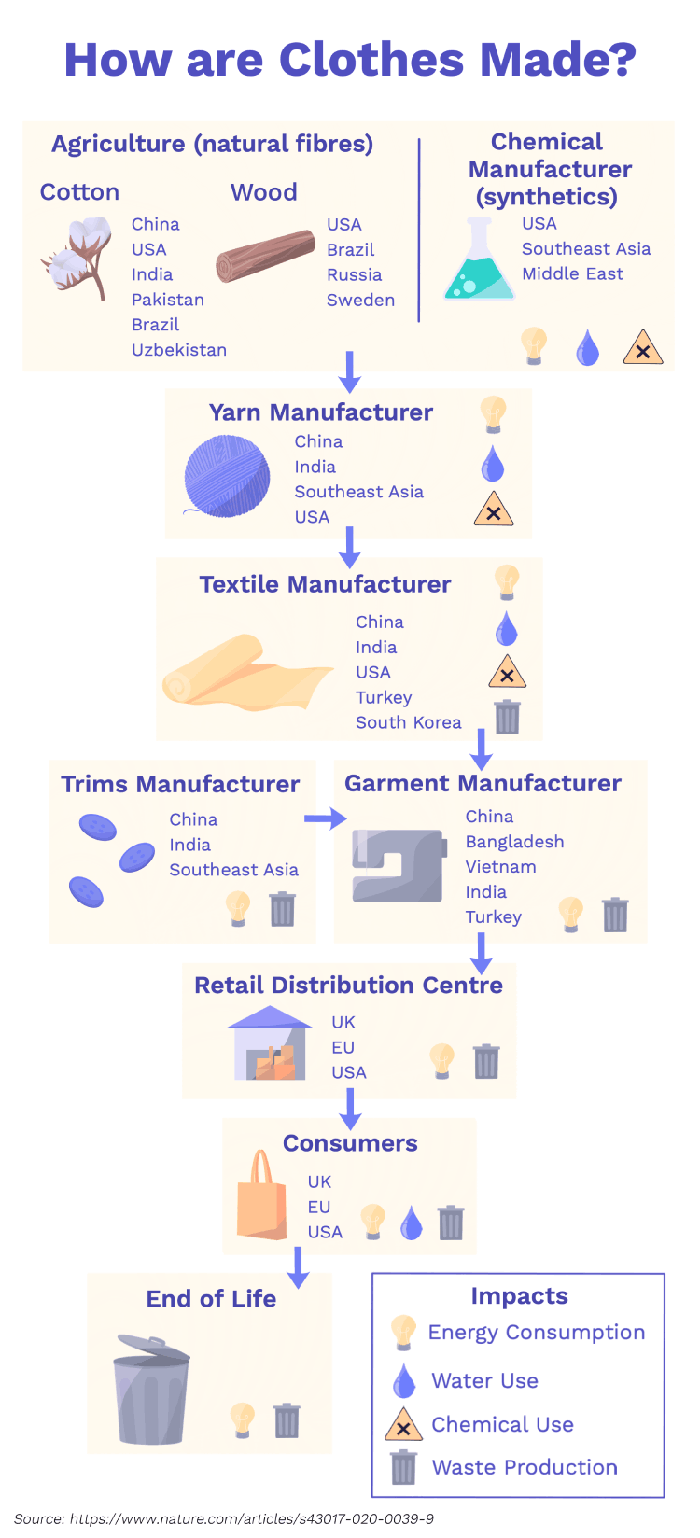
The fashion supply chain
Let’s look at these in more detail:
Polyester is the most commonly used fibre, accounting for 52.2% of global fibre production in 2019 . It is a synthetic plastic fibre made from fossil fuels through a process that is highly energy-intensive
. In 2015 alone, the production of polyester for textiles was estimated to release over 706 billion kg of greenhouse gases
. That’s equivalent to the annual emissions of 185 coal power plants! Even a single polyester t-shirt emits an average of 5.5 kg CO2eq, nearly 30% more than the average emissions from a cotton t-shirt
.
Cotton is a naturally-sourced, plant-based fibre, but any carbon it removes from the atmosphere as it grows is offset by the greenhouse gases released by the production and application of fertilisers and pesticides to the growing plants . These chemicals can also leak into surrounding environments, damaging local ecosystems, reducing soil quality, and posing a threat to human health
.
While cotton produces less greenhouse gas than polyester, it uses up 20x more water . A single cotton shirt requires 2700 litres of water to produce
, about as much as you drink in two-and-a-half years
!
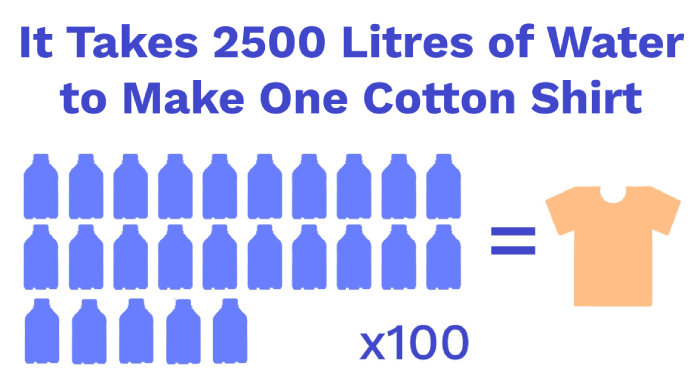
How much water is needed for one cotton shirt
Overall, the textile industry consumes around 79 billion litres of water every year . And it’s not just in fibre production; water is used in the dyeing, finishing and washing stages too
.
Because 90% of the world’s clothing is produced in low- and middle-income countries (due to the cheaper cost of labour), developing countries bear most of the burden of this environmental pollution despite accounting for only a small amount of clothing consumption
.
Use of these chemicals is also dangerous for the factory workers themselves . Daily exposure can have significant health consequences
, and poor political infrastructure and business management in many countries means that occupational and safety standards are often not enforced in textile factories
. In 2015, 14 million industry workers were paid less than half of the living wage required to meet basic needs, and 1.4 million workplace injuries were recorded
.
What about the impacts of clothes once they have been bought?
When clothing is washed it releases very small threads, called microfibres, which are released into the water and can eventually end up in our oceans. While microfibres from natural materials break down relatively quickly, those from synthetic materials stay around for a very long time and can be eaten by sea animals . A single machine wash of polyester clothing can release 700,000 plastic microfibres
.

Annual release of microfibres from washing clothes
What happens to our clothes when we are done with them?
Almost 60% of all clothing produced is thrown out within a year of its production, ending up in landfill or being incinerated . Waste also occurs at earlier stages of the fashion supply chain; 10-20% of fabric is wasted while it is cut into clothes
and millions of dollars of unsold clothing are burnt every year, releasing greenhouse gases and pollution into the air
.
So what can we do?
Most textiles and clothing are produced in countries that rely mainly on fossil fuels for energy production, like China . The textile industry uses a lot of energy, so switching to clean energy sources, like solar, wind and nuclear, and increasing energy efficiency is the most effective way to reduce the industry’s carbon footprint
.
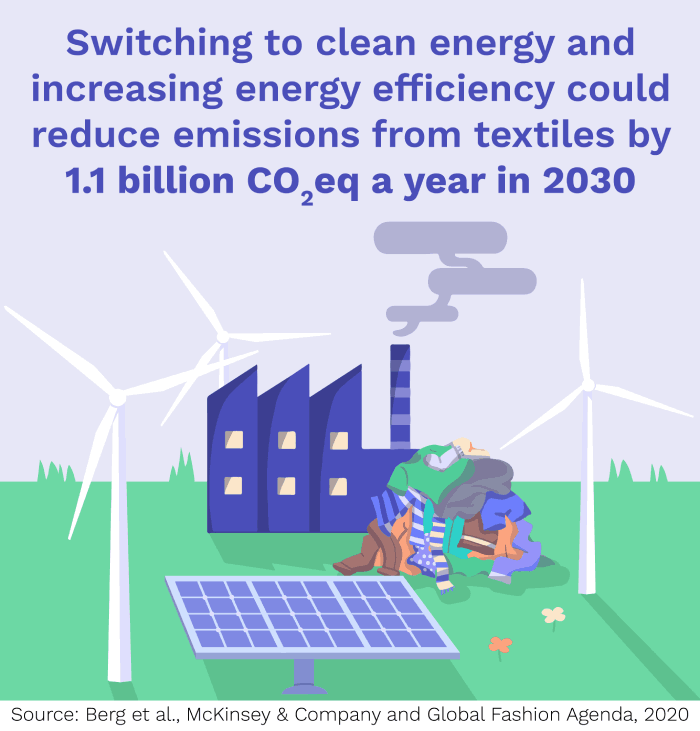
Emissions reduction by switching to clean energy
What about the fibres themselves?
Recycled polyester production releases 37% less CO₂ than virgin polyester (polyester produced from non-recycled fibres) and is made mostly from discarded plastic bottles and other plastic waste . Thus, recycled polyester has the potential to reduce plastic pollution as well as greenhouse gas emissions. While it is still slightly more expensive to produce than virgin polyester, more and more brands are turning to this recycled alternative
.

Emissions from recycled polyester
To solve these problems, short recycled fibres are often blended with longer fibres to produce durable clothing, and innovative technologies have been developed to automatically sort large volumes of mixed textiles by fibre type . A centralised approach to textile recycling will also be needed
and clothing must be designed with recyclability in mind
.
As well as recycling fibres, we should start using materials that produce lower emissions in the first place. Organic cotton is one possibility; because it does not use the harmful pesticides and fertilisers involved in conventional cotton production, it produces about half as many emissions .
But cotton is not the only naturally sourced fibre. Many other fibres use less water and land than cotton. This includes other fibres from plants, like hemp, and those which are man-made from wood, like viscose and lyocell. However, it is important that the materials used for these fibres are sustainably sourced and the chemicals used in their processing are recovered and reused
.
To avoid this, start-ups around the world have been working to produce natural alternatives to these fibres, particularly leather. For example, mushrooms grown on sawdust and agricultural waste , modified yeast
, and the bacteria used to make kombucha tea
have all been used to make leather alternatives.
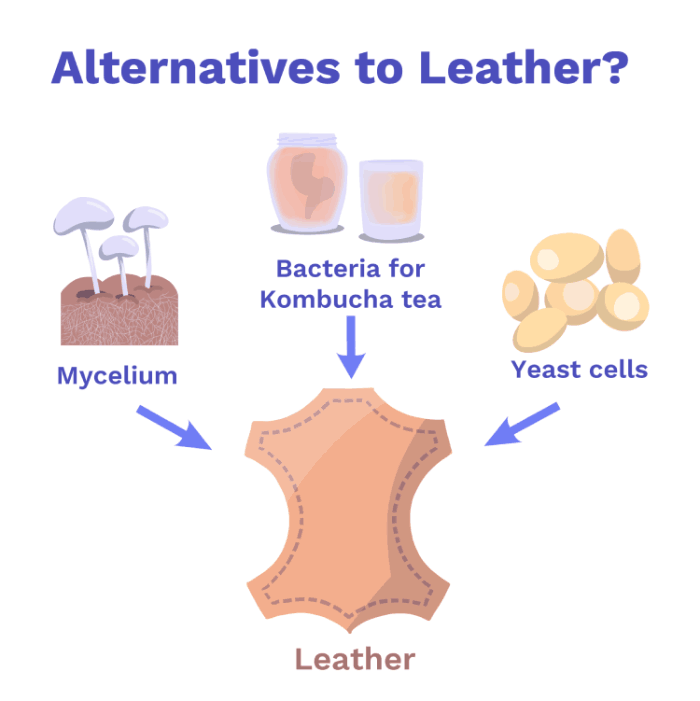
Leather alternatives
Other companies are working to produce sustainable fibres while fighting food waste , a problem responsible for 8-10% of global emissions
.
Although shifting to more sustainable fibres will help reduce the carbon footprint of the textile industry, the differences in environmental impact between different fibre suppliers are often greater than those between the different fibre types . Therefore, it is essential that we make changes within the supply chain itself.
How can we reduce the impact of textile manufacture?
Wet treatment processes, such as bleaching, dyeing and printing, have the largest environmental impact because lots of energy, water and chemicals are needed . Therefore, adopting dry processing methods, such as using pressurised CO₂ to dye fabrics instead of water, can significantly reduce emissions and water usage as well as wastewater pollution
.
Chemical pollution can also be avoided by improving the efficiency of the dyeing process. For example, a pretreatment for cotton called ColorZen makes the fibres more receptive to dye, thus reducing the amount of dye, water and energy required .
Even with these exciting innovations, significant improvements will require systemic change. Doing this requires transparency within the supply chain; the industry must establish higher labour and environmental standards, and both environmental and social concerns need to be considered at every stage. Some brands are already making changes in the right direction, but manufacturers, brands and governments will need to work together to have a significant impact .
As well as commitments from big businesses, we also need changes in consumer behaviour. New circular business models, like clothes rental and swapping services, could help shift the perception of clothing as being easily disposable . Such models could meet consumers’ desire for novelty and variety in their clothing while keeping the garments in circulation for longer
.
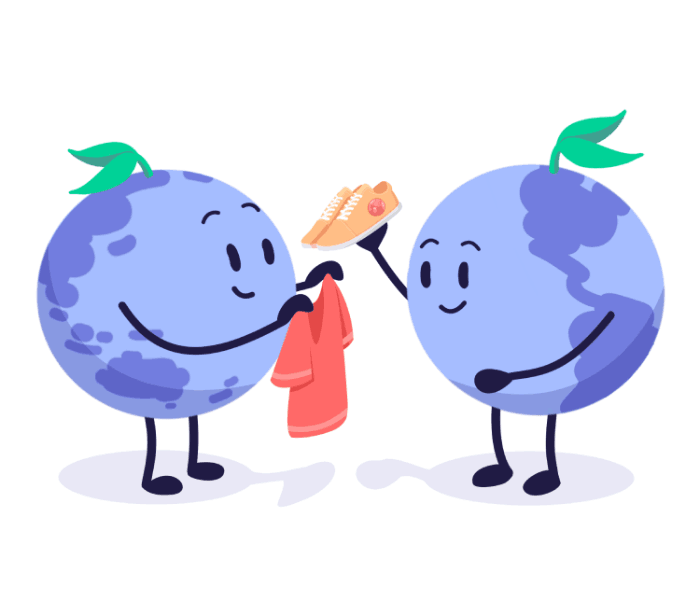
Circular clothing business models
Retailers and brands also have a responsibility to raise consumer awareness about the high energy requirements of washing, drying and ironing their clothes . Reducing washing temperatures and frequency, as well as avoiding tumble-drying, will reduce carbon emissions and water consumption while preventing the release of microfibres into our waterways
.
However, even if we adopt sustainable laundry practices, we still need to wash our clothes sometimes! To minimise our impact on the environment, we can make sure our washing machines are energy efficient, switch to clean energy providers, and use laundry filters such as coraballs to prevent the release of microfibres .
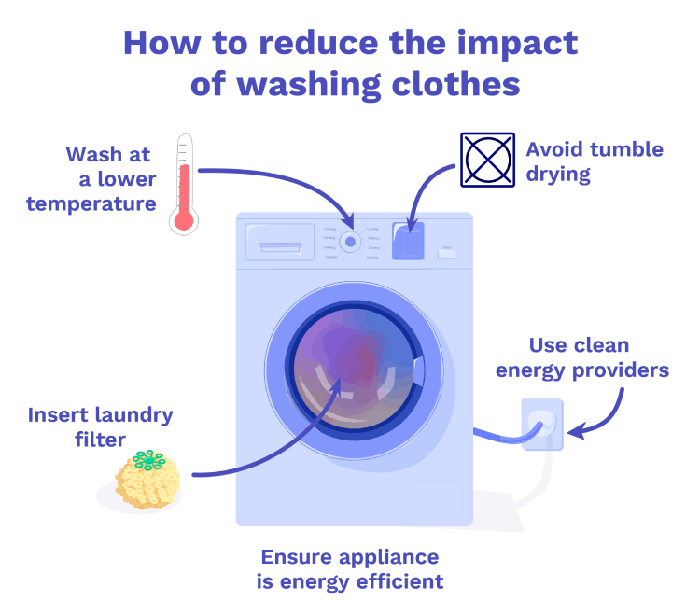
Reducing the impact of laundry
Conclusion
The textile industry is having serious impacts on both the environment and human well-being. Our love for fast fashion has dramatically increased the demand for cheap, low-quality garments that use up resources and contribute significantly to global emissions and waste. While we are seeing exciting advances in the production of sustainable fabrics and textile recycling, the best way to reduce the environmental and social impacts of this industry is to reduce the overproduction and consumption of textile items in the first place .